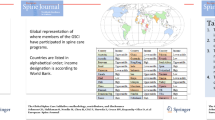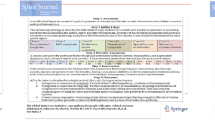Abstract
Purpose
The purpose of this study was to develop a stratification scheme for surgical spinal care to serve as a framework for referrals and distribution of patients with spinal disorders.
Methods
We used a modified Delphi process. A literature search identified experts for the consensus panel and the panel was expanded by inviting spine surgeons known to be global opinion leaders. After creating a seed document of five hierarchical levels of surgical care, a four-step modified Delphi process (question validation, collection of factors, evaluation of factors, re-evaluation of factors) was performed.
Results
Of 78 invited experts, 19 participated in round 1, and of the 19, 14 participated in 2, and 12 in 3 and 4. Consensus was fairly heterogeneous for levels of care 2–4 (moderate resources). Only simple assessment methods based on the clinical skills of the medical personnel were considered feasible and safe in low-resource settings. Diagnosis, staging, and treatment were deemed feasible and safe in a specialized spine center. Accurate diagnostic workup was deemed feasible and safe for lower levels of care complexity (from level 3 upwards) compared to non-invasive procedures (level 4) and the full range of invasive procedures (level 5).
Conclusion
This study introduces a five-level stratification scheme for the surgical care of spinal disorders. This stratification may provide input into the Global Spine Care Initiative care pathway that will be applied in medically underserved areas and low- and middle-income countries.
Graphical Abstract
These slides can be retrieved under Electronic Supplementary Material.



Similar content being viewed by others
References
Murray CJ, Vos T, Lozano R, Naghavi M, Flaxman AD, Michaud C et al (2012) Disability-adjusted life years (DALYs) for 291 diseases and injuries in 21 regions, 1990–2010: a systematic analysis for the Global Burden of Disease Study 2010. Lancet 380:2197–2223. https://doi.org/10.1016/S0140-6736(12)61689-4
Woolf AD, Pfleger B (2003) Burden of major musculoskeletal conditions. Bull World Health Organ 81:646–656
GBD 2015 Disease and Injury Incidence and Prevalence Collaborators (2016) Global, regional, and national incidence, prevalence, and years lived with disability for 310 diseases and injuries, 1990–2015: a systematic analysis for the Global Burden of Disease Study 2015. Lancet (London, England) 388:1545–1602. https://doi.org/10.1016/s0140-6736(16)31678-6
GBD 2015 DALYs and HALE Collaborators (2016) Global, regional, and national disability-adjusted life-years (DALYs) for 315 diseases and injuries and healthy life expectancy (HALE), 1990–2015: a systematic analysis for the Global Burden of Disease Study 2015. Lancet (London, England) 388:1603–1658. https://doi.org/10.1016/s0140-6736(16)31460-x
Louw QA, Morris LD, Grimmer-Somers K (2007) The prevalence of low back pain in Africa: a systematic review. BMC Musculoskelet Disord 8:105. https://doi.org/10.1186/1471-2474-8-105
Belachew DA, Schaller BJ, Guta Z (2008) Review paper <br> Cervical spondylosis: a literature review with attention to the African population. Arch Med Sci 3:315–322
World Health Organization (2013) Global action plan for the prevention and control of noncommunicable diseases 2013–2020. WHO Press, Geneva
Dalkey NC, Rourke DL (1972) Experimental assessment of Delphi procedures with group value judgments. In: Dalkey NC, Rourke DL, Lewis R, Snyder D (eds) Studies in the quality of life: Delphi anddecision-making. LexingtonBooks, Lexington, pp 55–83
Dalkey NC, Helmer O (1963) An experimental application of the Delphi method to the use of experts. Manag Sci 9:458–467
Ludlow J (1975) Delphi inquiries and knowledge utilization. In: Linstone HA, Turoff M (eds) The Delphi method: techniques and applications. Addison-Wesley Publishing Company, Reading, pp 102–123
Douglas DC (1983) A comparative study of the effectiveness of decision making processes which utilize the Delphi and leaderless group methodologies. The Ohio State University, Columbus
Helmer O, Rescher N (1959) On the epistemology of the inexact science. Manag Sci 6:25–53
Adams SJ (2001) Projecting the next decade in safety management: a Delphi technique study. Prof Saf 46:26–29
Hsu CC, Sandford BA (2007) The Delphi Technique: making sense of consensus. Pract Assess Res Eval 12:1–10
Zeliff ND, Heldenbrand SS (1993) What’s being done in the international business curriculum? Bus Educ Forum 48:23–25
Author information
Authors and Affiliations
Corresponding author
Ethics declarations
Funding
The Global Spine Care Initiative and this study were funded by Grants from the Skoll Foundation and NCMIC Foundation. World Spine Care provided financial management for this project. The funders had no role in study design, analysis, or preparation of this paper.
Conflict of interest
EAc declares grants: Depuy Synthes Spine, Medtronic; speaker’s bureau: AOSpine, Zimmer Biomet. TM declares fellowship grant-Medtronics. SY declares no COI. SA declares no COI. MN declares funding from Skoll Foundation and NCMIC Foundation through World Spine Care. Co-Chair, World Spine Care Research Committee. Palladian Health, Clinical Policy Advisory Board member. Book Royalties Wolters Kluwer and Springer. Honoraria for speaking at research method courses. KR declares funding to UOIT from Skoll Foundation, NCMIC Foundation through World Spine Care. SH declares funding to UOIT from Skoll Foundation, NCMIC Foundation through World Spine Care. Clinical Policy Advisory Board and stock holder, Palladian Health. Advisory Board, SpineHealth.com. Book Royalties, McGraw Hill. Travel expense reimbursement—CMCC Board.
Electronic supplementary material
Below is the link to the electronic supplementary material.
Appendix: Consensus Panel
Appendix: Consensus Panel
Michael Grevitt
Nottingham University Hospitals, Edwalton, Nottingham, United Kingdom
ORCID: None
Amer Aziz
Ghurki Trust Teaching Hospital Lahore Pakistan, Orthopaedics and Spine Department, Lahore, Punjab, Pakistan
ORCID: None
Elijah Muteti
Moi University/Moi Teaching and Referral Hospital, Eldoret, Kenya
ORCID: None
Norman Fisher-Jeffes
Private Practice-Panorama Medi Clinic and Sessional Consultant-Groote Schuur Hospital, Cape Town, Western Cape, South Africa
ORCID: None
Juan Emmerich
University of La Plata, La Plata, Buenos Aires, Argentina
ORCID: None
Robert Dunn
Department of Orthopaedic Surgery, University of Cape Town and Groote Schuur Hospital, Cape Town, Western Cape, South Africa
ORCID: http://orcid.org/0000-0002-3689-0346
Chung Chek Wong
Sarawak General Hospital, Kuching, Sarawak, Malaysia
ORCID: None
Emiliano Vialle
Catholic University of Parana, Curitiba, Paraná, Brasil
ORCID: http://orcid.org/0000-0003-1157-4889
Teresa Bas
Hospital Universitario and Politecnico La Fe, Valencia University at the Department of Surgery, Valencia, Spain
ORCID: None
Jean Pierre Farcy
Retired from Department of Orthopedic Surgery New York University, Piermont, New York, United States
ORCID: None
Consensus panel
MG declares no COI.
AA declares no COI.
EM declares AO Spine Africa Faculty courses—honorarium.
NFJ declares no COI.
JE declares no COI.
RD declares no COI.
CCW declares no COI.
EV declares no COI.
TB declares European Spine Journal provided a grant to investigate scoliosis.
JPF declares no COI.
Rights and permissions
About this article
Cite this article
Acaroğlu, E., Mmopelwa, T., Yüksel, S. et al. The Global Spine Care Initiative: a consensus process to develop and validate a stratification scheme for surgical care of spinal disorders as a guide for improved resource utilization in low- and middle-income communities. Eur Spine J 27 (Suppl 6), 879–888 (2018). https://doi.org/10.1007/s00586-017-5332-z
Received:
Revised:
Accepted:
Published:
Issue Date:
DOI: https://doi.org/10.1007/s00586-017-5332-z




